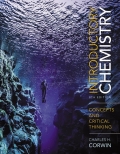
Concept explainers
(a)
Interpretation:
The mass of sulfur trioxide
Concept introduction:
Reactions can occur in multiple steps. Multiple stoichiometry reactions technique is used to calculate the amount of products formed. A relationship between the reactant and final product is found by including the products formed in each step. From the relation, stoichiometry and mole concept is used.
(b)
Interpretation:
The volume of sulfur trioxide produced at
Concept introduction:
Reactions can occur in multiple steps. Multiple stoichiometry reactions technique is used to calculate the amount of products formed. A relationship between the reactant and final product is found by including the products formed in each step. From the relation, stoichiometry and mole concept is used.
(c)
Interpretation:
The mass of sulfuric acid produced if the yield is
Concept introduction:
Reactions can occur in multiple steps. Multiple stoichiometry reactions technique is used to calculate the amount of products formed. A relationship between the reactant and final product is found by including the products formed in each step. From the relation, stoichiometry and mole concept is used.
Want to see the full answer?
Check out a sample textbook solution
Chapter 15 Solutions
EBK INTRODUCTORY CHEMISTRY
- Calculate the pH and the pOH of each of the following solutions at 25 °C for which the substances ionize completely: (a) 0.000259 M HClO4arrow_forwardWhat is the pH of a 1.0 L buffer made with 0.300 mol of HF (Ka = 6.8 × 10⁻⁴) and 0.200 mol of NaF to which 0.160 mol of NaOH were added?arrow_forwardDetermine if the following salt is neutral, acidic or basic. If acidic or basic, write the appropriate equilibrium equation for the acid or base that exists when the salt is dissolved in aqueous solution. If neutral, simply write only NR. Be sure to include the proper phases for all species within the reaction. NaN₃arrow_forward
- A. Draw the structure of each of the following alcohols. Then draw and name the product you would expect to produce by the oxidation of each. a. 4-Methyl-2-heptanol b. 3,4-Dimethyl-1-pentanol c. 4-Ethyl-2-heptanol d. 5,7-Dichloro-3-heptanolarrow_forwardWhat is the pH of a 1.0 L buffer made with 0.300 mol of HF (Ka = 6.8 × 10⁻⁴) and 0.200 mol of NaF to which 0.160 mol of NaOH were added?arrow_forwardCan I please get help with this.arrow_forward
- Determine if the following salt is neutral, acidic or basic. If acidic or basic, write the appropriate equilibrium equation for the acid or base that exists when the salt is dissolved in aqueous solution. If neutral, simply write only NR. Be sure to include the proper phases for all species within the reaction. N₂H₅ClO₄arrow_forwardPlease help me with identifying these.arrow_forwardCan I please get help with this?arrow_forward
 Chemistry: Principles and ReactionsChemistryISBN:9781305079373Author:William L. Masterton, Cecile N. HurleyPublisher:Cengage Learning
Chemistry: Principles and ReactionsChemistryISBN:9781305079373Author:William L. Masterton, Cecile N. HurleyPublisher:Cengage Learning Chemistry & Chemical ReactivityChemistryISBN:9781337399074Author:John C. Kotz, Paul M. Treichel, John Townsend, David TreichelPublisher:Cengage Learning
Chemistry & Chemical ReactivityChemistryISBN:9781337399074Author:John C. Kotz, Paul M. Treichel, John Townsend, David TreichelPublisher:Cengage Learning

